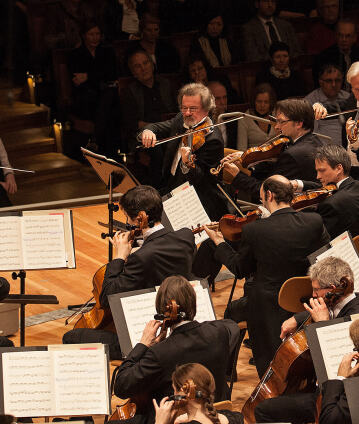Conclusion of the Sibelius cycle with Simon Rattle

Complete symphonic performances are always a special event for the Berliner Philharmoniker. That includes this Sibelius cycle from 2015, which culminated in Simon Rattle conducting three symphonies in a row. Sibelius’s Symphonies Nos. 5, 6 and 7 fuse the qualities of the preceding works: the effusive Nordic tone of the first two symphonies, and the experimental form language and harmonies of Symphonies Nos. 3 and 4.
In his Fifth Symphony, which ends with a grandiose song of nature, Sibelius again applied himself to the “big tone” in the traditional heroic key: E flat major. The work ends with a highly effective finale, in essence based on a figure in the winds that the composer himself designated a “swan hymn”: “Today at ten to eleven I saw 16 swans. One of my greatest experiences! The Fifth Symphony’s Finale-theme: Legato in the trumpets!” Sibelius’s Sixth, in contrast, which largely dispenses with the otherwise typical rhapsodic discontinuities and contradictions and also has markedly concertante characteristics, lives from a never-ending flow of the melodic figures, set out in front of listeners in filigree, polyphonic curved lines. The music of a romantic impetus is enhanced in the Finale “in a dark orchestral roar in which the main theme drowns” (Sibelius), before a melancholy string movement leads to the conclusion.
How much Sibelius had departed in his symphonic works from the traditional canon of forms can last be heard in his one-movement Seventh Symphony, premiered as Fantasia sinfonica, which Simon Rattle performs directly following the Sixth: starting from an adagio tone in the strings reminiscent of Mahler, the music progresses through many stages to a fateful climax, before a Largamente conclusion again takes up the plaintive character of the beginning. This performance of Symphomies Nos. 5, 6 and 7 concluded Sir Simon Rattle’s Sibelius cycle with the Philharmoniker.
© 2015 Berlin Phil Media GmbH
Artists
Our recommendations
- Simon Rattle conducts Beethoven’s “Pastoral” Symphony and Modernist concertos
- Simon Rattle conducts Berlin school orchestras
- Beethoven and Mozart with Simon Rattle and Mitsuko Uchida at the Easter Festival
- Simon Rattle conducts Mahler’s Second Symphony
- Krystian Zimerman plays Brahms
- Simon Rattle conducts Mahler’s Third Symphony